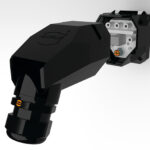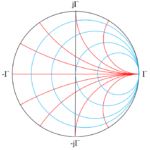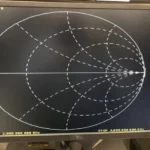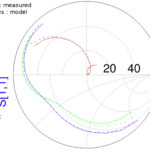It’s a tenet of the test-and-measurement industry that you should concentrate on looking for defects in your device under test (DUT) — not in your test equipment. Figure 1 illustrates a common problem. An instrument presents an incorrect reading; in this case, an LRC meter or multimeter presents a resistance reading that’s about 5% low. Using four wires is a good start. The extra two wires remove errors in the wires by moving the measurement plane out to the DUT. That’s fine if you’re connecting the DUT directly to your probes without a test fixture. If you need a fixture to hold the DUT, the solution here is to calibrate the instrument-and-fixture combination pre-test — before using it to measure the resistance of any DUTs.

Figure 2 illustrates another problem. You might be using an instrument such as a vector network analyzer (VNA) to measure insertion loss, return loss, or some other parameters. Your VNA probably has a 50-W connector. If your DUT is a millimeter-wave IC, it probably doesn’t. Consequently, you need a test fixture. As a result, your instrument isn’t measuring the DUT — it’s measuring the DUT plus the cables plus the fixture. A standard calibration kit will enable you to extend the calibration plane out to the end of the cables, but not all the way to the device plane, as shown in Figure 2. So even if the VNA is perfectly calibrated, it will give you a precise measurement of the DUT plus the fixture but not of the DUT itself. We need to mathematically remove the characteristics of the fixture from the combined DUT plus fixture measurement. That post-test process is known as de-embedding.
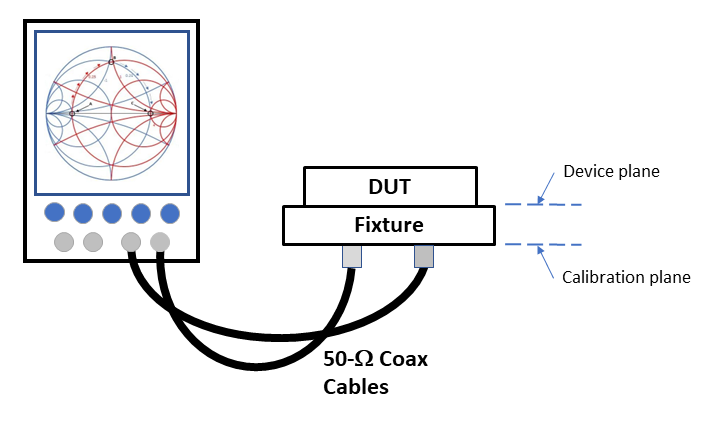
How can I find the characteristics of the fixture?
You could try to measure the fixture directly with your VNA if you could extend the VNA’s calibration plane to the noncoaxial top of the fixture in Figure 2. But if you could do that conveniently, you probably wouldn’t need the fixture to start with. Typically, engineers use a solver to develop a model based on a detailed description of the fixture, including physical dimensions, materials, and dielectric constants. Companies, including Ansys, CST, Keysight, MathWorks, and NI offer software suites that can create these models or perform calculations based on them.
So, then it’s just a simple subtraction problem, right?
Not quite. The models and VNA measurements will be in terms of scattering parameters (S-parameters), as shown in Figure 3. An S-parameter matrix simply describes how incident waves reflect from or pass through a network.
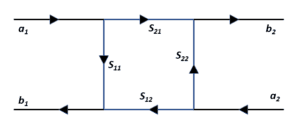
The S-parameters for a two-port network in Figure 3 relate the incident waves a1 and a2 to the reflected and transmitted waves b1 and b2 according to the following matrix equation:
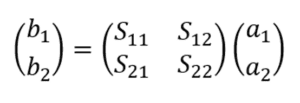
We’ll let SDUT be our shorthand way of representing our DUT’s S-parameter matrix. Now consider the fixture. Since it’s designed to measure a two-port device, it has two sections — let’s call them the input and output sections — represented by the S-parameter matrices SFI and SFO, respectively. It can be helpful to illustrate them as shown in Figure 4.

It looks like we can just wire them up and have a combined S-parameter representation of the DUT and fixture?
If those were gain stages, we could do that — cascade them and multiply the values of each gain stage. That would provide a convenient way to find the gain of the DUT, even if we couldn’t measure it in isolation from the fixture. For example, say we know from models or from direct measurement that the fixture input section has a gain of 2, and the fixture output section has a gain of 1.5. Then, we measure the combined fixture and DUT and find a total gain of 15. Analogous to de-embedding, the gain of the DUT is therefore 15 divided by 2 divided by 1.5, for a DUT gain of 5.
Unfortunately, S-parameters don’t work that way. You’ll note that Equation 1 is not in the form of outputs being a function of inputs from either a left-to-right or right-to-left signal-flow perspective. To extract the characteristics of the DUT from the combined characteristics of the DUT plus fixture, we will need to employ transfer scattering parameters, or T-parameters, which I will discuss in part 2.
Meanwhile, you can learn more about S-parameters here. And if you want to learn more about pretest calibration, fluke calibration has a good introduction.

